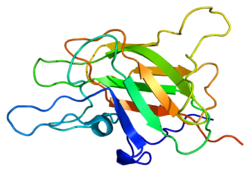First described in humans, a g factor has since been identified in a number of non-human species. Non-human models of g have been used in genetic and neurological...
11 KB (1,514 words) - 08:02, 2 May 2024
Intelligence (section g factor in non-humans)
factor of intelligence has been observed in non-human animals. First described in humans, the g factor has since been identified in a number of non-human...
46 KB (4,818 words) - 01:56, 31 May 2025
The g factor is a construct developed in psychometric investigations of cognitive abilities and human intelligence. It is a variable that summarizes positive...
125 KB (15,459 words) - 04:10, 2 June 2025
Animal cognition (redirect from Non-human animal intelligence)
evidence for general intelligence is weak in non-human animals. The general factor of intelligence, or g factor, is a psychometric construct that summarizes...
123 KB (15,111 words) - 18:04, 9 June 2025
intelligence Deception in animals Dog intelligence Fish intelligence Human-animal communication Theory of mind in animals g factor in non-humans Dukas, Reuven...
16 KB (2,064 words) - 04:42, 16 May 2025
Ergonomics (redirect from Human-factor engineering)
methods to non-work-related situations. A "human factor" is a physical or cognitive property of an individual or social behavior specific to humans that may...
66 KB (8,102 words) - 14:14, 8 June 2025
The g Factor: The Science of Mental Ability is a 1998 book by psychologist Arthur Jensen about the general factor of human mental ability, or g. The book...
9 KB (1,130 words) - 02:19, 28 May 2024
Animal sexual behaviour (redirect from Sexual pleasure in non-human animals)
Prolactin influences social bonding in rats. Oxytocin plays a similar role in non-human primates as it does in humans. Grooming, sex, and cuddling frequencies...
129 KB (14,163 words) - 04:12, 10 June 2025
Granulocyte colony-stimulating factor (G-CSF or GCSF), also known as colony-stimulating factor 3 (CSF 3), is a glycoprotein that stimulates the bone marrow...
33 KB (3,830 words) - 21:00, 29 May 2025
Factor XIII, or fibrin stabilizing factor, is a plasma protein and zymogen. It is activated by thrombin to factor XIIIa which crosslinks fibrin in coagulation...
8 KB (987 words) - 20:14, 25 March 2025
Albinism is a congenital condition characterized in humans by the partial or complete absence of pigment in the skin, hair and eyes. Albinism is associated...
42 KB (4,167 words) - 07:37, 11 June 2025
with human blood group reagents, but the structure of the blood group antigens in animals is not always identical to those typically found in humans. The...
15 KB (1,843 words) - 05:26, 7 January 2025
acceleration of gravity, also indicated with g. The load factor is strictly non-dimensional. The use of g units refers to the fact that an observer on board...
9 KB (1,173 words) - 09:56, 11 July 2024
Coagulation factor VIII (Factor VIII, FVIII, also known as anti-hemophilic factor (AHF)) is an essential blood clotting protein. In humans, it is encoded...
17 KB (2,002 words) - 02:02, 28 May 2025
Human factors are the physical or cognitive properties of individuals, or social behavior which is specific to humans, and which influence functioning...
102 KB (12,546 words) - 20:12, 7 September 2024
Brain-derived neurotrophic factor (BDNF), or abrineurin, is a protein that, in humans, is encoded by the BDNF gene. BDNF is a member of the neurotrophin...
50 KB (5,881 words) - 13:31, 5 May 2025
juvenile traits well into adulthood. In humans, this trend is greatly amplified, especially when compared to non-human primates. Neotenic features of the...
54 KB (6,751 words) - 12:12, 24 May 2025
April 2022. Retrieved 20 December 2020. "Prevalence of Non-communicable Disease Risk Factors in Cambodia" (PDF). World Health Organization. 2010. p. 157...
164 KB (8,473 words) - 05:18, 1 April 2025
anthropometry Human height List of heaviest people Obesity Overweight Set point theory Stone (unit) § human body weight Thermoregulation in humans Underweight...
46 KB (2,521 words) - 21:56, 28 May 2025
Coagulation factor V (Factor V), also less commonly known as proaccelerin or labile factor, is a protein involved in coagulation, encoded, in humans, by F5...
14 KB (1,815 words) - 16:06, 4 May 2025
Human sexual activity, human sexual practice or human sexual behaviour is the manner in which humans experience and express their sexuality. People engage...
73 KB (8,011 words) - 00:32, 12 June 2025
developed his two-factor theory of intelligence using factor analysis. His research not only led him to develop the concept of the g factor of general intelligence...
15 KB (1,827 words) - 10:37, 27 December 2024
Abiotic component (redirect from Abiotic factor)
In biology and ecology, abiotic components or abiotic factors are non-living chemical and physical parts of the environment that affect living organisms...
6 KB (660 words) - 17:21, 22 October 2024
Humans (Homo sapiens) or modern humans are the most common and widespread species of primate, and the last surviving species of the genus Homo. They are...
266 KB (25,626 words) - 23:15, 13 June 2025
schedule; Diurnal organisms, such as humans, prefer to sleep at night; Nocturnal organisms, such as rats, prefer to sleep in the day; Crepuscular organisms...
66 KB (7,970 words) - 00:58, 8 June 2025
environmental factor, ecological factor or eco factor is any factor, abiotic or biotic, that influences living organisms. Abiotic factors include ambient...
29 KB (3,291 words) - 12:55, 23 May 2025
protease (or serine endopeptidase) class. In humans, factor XII is encoded by F12 gene. The gene for factor XII is located on the tip of the long arm...
25 KB (3,097 words) - 13:16, 30 May 2025
Fibroblast growth factor 21 (FGF-21) is a protein that in mammals is encoded by the FGF21 gene. The protein encoded by this gene is a member of the fibroblast...
24 KB (3,038 words) - 23:40, 29 November 2024
non-human cells as human cells. Some microorganisms that humans host are commensal, meaning they co-exist without harming humans; others have a mutualistic...
108 KB (11,995 words) - 05:27, 9 June 2025
Primate (redirect from Non-human primate)
transmitted to humans; in some cases the viruses produce potentially fatal diseases in both humans and non-human primates. Only humans are recognized...
162 KB (16,891 words) - 22:05, 19 May 2025
















